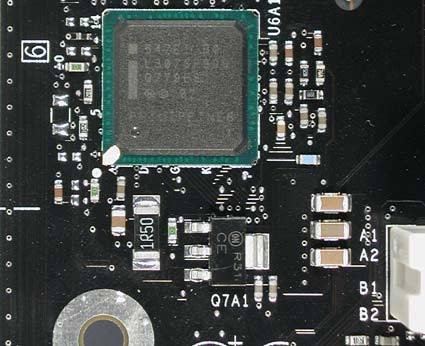All Aboard! P4 with 200 MHz FSB and the i875P Dual DDR400 Chipset
Gigabit-LAN: Northbound
The tasks assigned to the northbridge and southbridge change as infrequently as the political powers in some regimes. Just think about the last milestone: the introduction of AGP took place in the beginning of 1997. At that time, the PCI bus was to be relieved of its load, and the northbridge was made responsible for the connection to the graphics card. Six years later, we are finally seeing another change - at least with the connection between the northbridge and southbridge via the Hub Link architecture from Intel. This connection has a bandwidth of only 266 MB/s. In the worst case scenario, the following components could be slowed down at maximum load:
- IDE RAID0: 100 MB/s;
- 1 GB/s LAN: 125 MB/s;
- USB 2.0: 60 MB/s;
- TV tuner PCI card: 21 MB/s;
- Serial ATA: 150 MB/s.
In total, this would result in a theoretical maximum load of 456 MB/s (sound card and other components not even included). The 266 MB/s-wide Hub Link would also be mercilessly overloaded. Intel recognized this and thus offers the option of moving the network chip from the southbridge ICH5 to the northbridge 8287P, because ultimately, this is the component that can really gobble up a lot of bandwidth.
With the Communications Streaming Architecture (CSA), network chips of the gigabit class with 266 MB/s can be connected to the northbridge, without putting a load on the communication to ICH5 via Hub Link. The advantages here are short latencies and less load on the CPU. In order to make this at least a little bit profitable, the CSA protocol has been licensed. It's not certain whether Intel wants to demand license fees from network chip manufacturers such as 3Com, Realtek, D-Link or Boardcom, or whether the company simply wants to push the prices of its in-house Intel chips 20% to 30% higher - this information is under close wraps for now. Legally, Intel is on the safe side, because it is still possible to connect a network chip to the southbridge ICH5 - at the price of putting the load on the Hub Link connection, however.
New reference from Intel: with CSA technology, the gigabit network chip can communicate directly with the northbridge.
Asus doesn't use CSA technology yet. The gigabit LAN chip comes from 3Com and has to be connected via the Southbridge ICH5 (PCI). 3Com has a market share of 50%, and furthermore, its offering is 20% to 30% cheaper than GBit LAN chips with CSA from Intel.
Get Tom's Hardware's best news and in-depth reviews, straight to your inbox.
Current page: Gigabit-LAN: Northbound
Prev Page We Save Everything! Images Of The Latest 875P Boards Next Page Southbridge 82801EB/R (ICH5)

